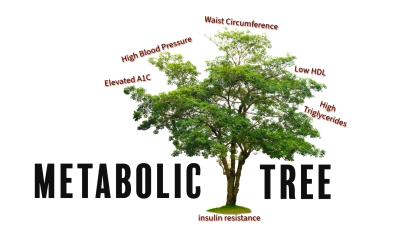
It's Simpler Than You Think
By Mary Lou Block RDN LMNT
Overwhelmed by metabolic risk factors and related health concerns that confound and worry you? Deciphering them is simpler than you think, and it’s the perfect time to begin as we enter 2024.
5 Branches of the Metabolic Tree
Metabolic risk factors can be thought of as five branches on a single tree. Each one (elevated A1C, high blood pressure, waist circumference, low HDL, and high TG) are branches of the same, single tree. The name inscribed on the tree trunk is “insulin resistance”.
Cutting Down the Tree
Cut down the “insulin resistance” tree trunk, and all branches of the tree come down. In other words, all 5 risk factors improve when insulin resistance is addressed. Conversely, allow the insulin resistance tree to grow, and all five branches come back!
A combination of lifestyle changes (diet, sleep, and exercise) will help you cut down that nasty tree.
Addressing Diet
Eat blood-sugar-regulating foods to reduce insulin resistance. How?
Reduce or eliminate concentrated sweets in pop, sugar-sweetened beverages, and real fruit juice. Pop and sugar-sweetened beverages are obvious, but many people don’t realize that naturally occurring sugar in real fruit juice raises blood sugar and affects insulin resistance as well. Next, limit or eliminate candy, desserts, pastries, doughnuts, and snack foods that contain added sugar in any form. Scour the label and look for ingredients such as sugar, cane sugar, organic cane sugar, fructose, high fructose corn syrup, agave nectar, etc.
Another important tip in regulating blood sugar is to fuel your brain and body with protein. You can do this by eating protein at each meal and when you are hungry between meals. Take protein snacks to activities and work. Consider eating it every 4 hours.
Make sure to add healthy fat to add satiety to your food. Low fat food is usually high in carbohydrate and empty of the nutrient density of their full fat counterparts. Healthy fats are those that appear in nature. Any processed fats are often unstable, easily oxidized, and unhealthy.
Vegetables, especially low carb vegetables help stabilize blood sugar when eaten together with healthy protein and fat foods. In addition, they provide a host of vitamins, mineral, and antioxidants that act as co-factors in biochemical reactions. These important biochemical reactions provide energy, vitality and unseen health benefits.
Tree trimming time!
Do you have evidence of an unsightly tree that needs your attention? 2024 is the time to get your chain saw out!
Need help getting started? Make an appointment to see Mary Lou by calling 308-537-3661.






